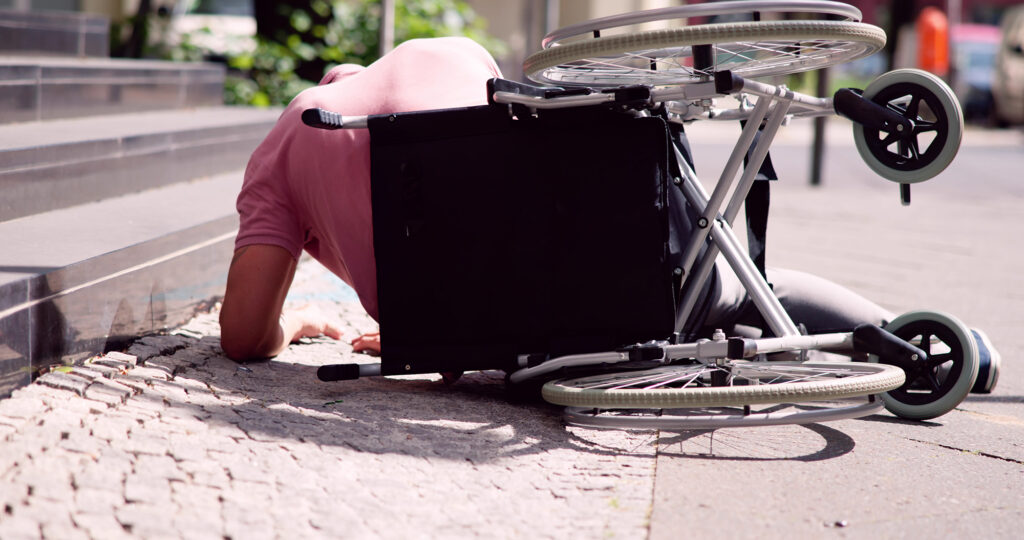Wheelchair Tip-Over Accident Lawsuit
Welcome to www.wheelchairinjurylawyer.com, your trusted resource for legal assistance if you or a loved one has suffered injuries due to a wheelchair tip-over accident. This comprehensive guide will discuss the biomedical aspects of wheelchair tip-over injuries, preventive measures to avoid such accidents, and your legal options for seeking compensation from manufacturers or other responsible parties.

Understanding Wheelchair Tip-Over Accidents
Wheelchair tip-over accidents can lead to severe injuries and significantly impact the lives of those who rely on these devices for mobility. Tip-overs can occur for various reasons, including design flaws, user error, and environmental hazards. Understanding the causes and consequences of these accidents is crucial for preventing them and seeking appropriate legal recourse when they occur.
Types of Wheelchair Tip-Over Accidents
Wheelchair tip-over accidents can be categorized based on the direction of the tip-over and the contributing factors. Common types include:
1. Forward Tip-Overs
Forward tip-overs occur when the wheelchair tips forward, causing the user to fall out of the chair. These can result from:
- Steep Inclines: Navigating steep ramps or slopes can cause the wheelchair to tip forward.
- Sudden Stops: Abruptly stopping can shift the user’s weight forward, leading to a tip-over.
- Improper Weight Distribution: Carrying heavy items on the front of the wheelchair can make it unstable.
2. Backward Tip-Overs
Backward tip-overs occur when the wheelchair tips backward, often due to:
- Steep Declines: Descending steep slopes can cause the wheelchair to tip backward.
- Improper Seating Position: Leaning too far back in the wheelchair can shift the center of gravity.
- Wheelchair Design Flaws: Some wheelchairs have a high center of gravity, making them prone to tipping backward.
- Lack of Anti-Tip Over Rear Wheels.
3. Sideways Tip-Overs
Sideways tip-overs happen when the wheelchair tips to the side, which can be caused by:
- Uneven Surfaces: Traversing uneven or rough terrain can lead to loss of balance and a sideways tip-over.
- Sharp Turns: Making sharp or sudden turns at high speed can cause the wheelchair to tip over.
- Improper Use of Anti-Tip Devices: Not using or improperly using anti-tip devices can increase the risk of sideways tip-overs.
- Frame Back and side panel failures can result in sudden tip-overs.
Biomedical Aspects of Wheelchair Tip-Over Injuries
Wheelchair tip-over accidents can lead to various injuries, ranging from minor bruises to severe, life-threatening conditions. The biomedical aspects of these injuries are critical to understanding the impact on the victim’s health and well-being.
Common Injuries Sustained in Tip-Over Accidents
- Traumatic Brain Injuries (TBI): When the head strikes the ground or other hard surfaces during a tip-over, it can result in TBIs, leading to cognitive deficits, memory loss, and personality changes.
- Concussions: A concussion is a mild form of TBI that can cause headaches, dizziness, and confusion.
- Paralysis: Damage to the spinal cord can cause partial or complete paralysis, affecting mobility and independence.
- Nerve Damage: Injuries to the spinal cord can also cause nerve damage, leading to chronic pain and loss of sensation.
- Broken Bones: The impact of a fall can result in broken bones, particularly in the arms, legs, and ribs.
- Pelvic Fractures: The pelvis can be especially vulnerable in tip-over accidents, leading to fractures that require long-term rehabilitation.
- Organ Damage: The force of the fall can cause internal injuries, such as damage to the liver, kidneys, and spleen.
- Internal Bleeding: These injuries can also lead to internal bleeding, which can be life-threatening if not treated promptly.
- Whiplash: The sudden jolt of a tip-over can cause whiplash, resulting in neck pain and stiffness.
- Bruises and Lacerations: Impact with hard surfaces can cause bruises and cuts that may require medical attention.
Severe injuries may require ongoing care and assistance. Recoverable damages for care and assistance can include:
- In-Home Care: Costs for hiring in-home care providers to assist with daily activities and medical needs.
- Assisted Living: Expenses for residing in an assisted living facility or nursing home if in-home care is not sufficient.

Long-Term Medical Complications
In addition to immediate injuries, wheelchair tip-over accidents can lead to long-term medical complications, such as:
- Chronic Pain: Injuries sustained in a tip-over can result in ongoing pain and discomfort.
- Reduced Mobility: Fractures, spinal injuries, and other severe injuries can limit mobility and independence.
- Emotional and Psychological Effects: The trauma of a tip-over accident can lead to anxiety, depression, and a reduced quality of life.
Preventing Wheelchair Tip-Over Accidents
Preventing wheelchair tip-over accidents involves a combination of proper wheelchair design, user education, and environmental modifications. Here are some measures that can be taken to enhance safety:
1. Proper Wheelchair Design
- Low Center of Gravity: Wheelchairs designed with a low center of gravity are less prone to tipping over.
- Anti-Tip Devices: Installing anti-tip devices can help prevent backward and sideways tip-overs.
- Stable Base: A wider base of support can increase stability and reduce the risk of tip-overs.
2. User Education and Training
- Safe Navigation Techniques: Users should be trained on how to navigate slopes, turns, and uneven surfaces safely.
- Proper Weight Distribution: Users should be informed about the importance of proper weight distribution and avoiding carrying heavy items on the wheelchair.
- Use of Restraints: Using seat belts and other restraints can help keep the user secure in the wheelchair.
3. Environmental Modifications
- Accessible Pathways: Ensuring that pathways, ramps, and sidewalks are smooth and even can reduce the risk of tip-overs.
- Proper Ramp Design: Ramps should have a gentle slope and be equipped with handrails and non-slip surfaces.
- Obstacle-Free Environment: Keeping the environment free of obstacles and hazards can help prevent accidents.
Legal Options for Injured Persons
If you have been injured due to a wheelchair tip-over accident, you may be entitled to compensation. Understanding your legal options can help you navigate the process and ensure you receive the justice you deserve.
Filing a Lawsuit Against the Manufacturer
Manufacturers are responsible for ensuring their products are safe for use. If a manufacturing defect or design flaw caused your injury, you might have grounds to file a product liability lawsuit.
- Strict Liability: Manufacturers can be held strictly liable for injuries caused by defective products, meaning you do not need to prove negligence, only that the product was defective and caused your injury.
- Negligence: If the manufacturer failed to exercise reasonable care in the design, production, or quality control of the wheelchair, they could be held liable for negligence.
- Breach of Warranty: If the wheelchair failed to meet the standards promised by the manufacturer, you might claim breach of warranty.
Filing a Lawsuit Against the Maintenance Company
Maintenance companies are responsible for ensuring that wheelchairs are properly serviced and safe to use. If improper maintenance caused your injury, you might have grounds to file a negligence lawsuit against the maintenance provider.
- Negligent Repairs: If the maintenance company performed substandard repairs or failed to identify and fix issues, they could be held liable for negligence.
- Failure to Inspect: If regular inspections were not conducted or were done inadequately, leading to unnoticed defects, the maintenance company could be liable.
Filing a Lawsuit Against Property Owners or Managers
Property owners and managers are responsible for ensuring that their premises are safe and accessible for wheelchair users. If environmental hazards or inadequate facilities caused your injury, you might have grounds to file a premises liability lawsuit.
- Unsafe Ramps and Pathways: Poorly designed or maintained ramps and pathways can cause accidents, and the property owner may be held liable.
- Hazardous Conditions: Obstacles, debris, or slippery surfaces can lead to wheelchair accidents, and the property owner could be held responsible.
Gathering Evidence
To build a strong case, gathering and preserving evidence is crucial. Important steps include:
- Documenting the Incident: Take photos and videos of the accident scene, the wheelchair, and your injuries.
- Saving the Wheelchair and Parts: Preserve the wheelchair and any parts involved in the tip-over in their post-accident condition as evidence.
- Collecting Medical Records: Keep detailed records of your medical treatment and expenses.
- Witness Statements: Gather statements from witnesses who saw the accident or can attest to the conditions and securement methods used.
Consulting with a Personal Injury Lawyer
An experienced personal injury lawyer specializing in wheelchair accident cases can provide invaluable guidance and representation. They can help you understand your legal rights, gather evidence, and navigate the complex legal process.
Free Consultation
Most personal injury lawyers offer free initial consultations to discuss your case and legal options.
Contingency Fee Basis
Many lawyers work on a contingency fee basis, meaning you do not pay legal fees unless they win your case.
Contact Us Today
Wheelchair tip-over accidents can have devastating consequences, leading to severe injuries and significant emotional and financial burdens. If you have been injured due to a wheelchair tip-over accident, it is crucial to understand your legal options and take the necessary steps to seek compensation. At www.wheelchairinjurylawyer.com, we are dedicated to helping victims of wheelchair accidents. Our experienced personal injury lawyers are here to provide the support and guidance you need.